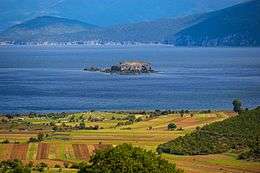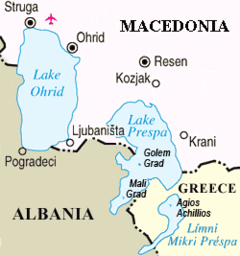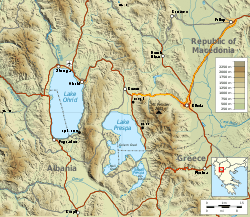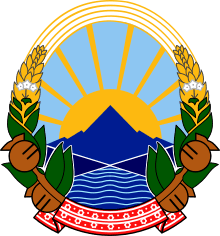Lake Prespa
| Lake Prespa | |
|---|---|
 The Island of Maligrad in the Albanian part of the Lake | |
 Location | |
| Location | Balkans (Albania, Greece, the Republic of Macedonia) |
| Coordinates | 40°54′N 21°02′E / 40.900°N 21.033°ECoordinates: 40°54′N 21°02′E / 40.900°N 21.033°E |
| Type | tectonic |
| Primary outflows | Lake Ohrid via karstic channels |
| Basin countries | Albania, Greece, Macedonia |
| Surface area | 259 km2 (100 sq mi) |
| Max. depth | 54 m (177 ft) |
| Surface elevation | 853 m (2,799 ft) |
| Islands | Golem Grad, Mal Grad |
| Official name | Lake Prespa |
| Designated | 4 April 1995 |
| Reference no. | 726[1] |
| Official name | Albanian Prespa Lakes |
| Designated | 13 June 2013 |
| Reference no. | 2151[2] |
The Prespa lakes are two freshwater lakes in southeast Europe, shared by Albania, Greece, and the Republic of Macedonia. Of the total surface area, 176.3 km2 (68.07 sq mi) belongs to the Republic of Macedonia, 46.3 km2 (17.88 sq mi) to Albania and 36.4 km2 (14.05 sq mi) to Greece. They are the highest tectonic lakes in the Balkans, standing at an elevation of 853 m (2,798 ft).
The Great Prespa Lake (Albanian: Liqeni i Prespës, Greek: Μεγάλη Πρέσπα, Megáli Préspa, Macedonian: Преспанско Езеро, Prespansko Ezero) is divided between Albania, Greece and Macedonia. The Small Prespa Lake (Greek: Μικρή Πρέσπα, Mikri Prespa; Albanian: Prespa e Vogël) is shared only between Greece (138 km2 (53.28 sq mi) drainage area; 42.5 km2 (16.41 sq mi) surface area) and Albania (51 km2 (19.69 sq mi) drainage area; 4.3 km2 (1.66 sq mi) surface area).
The area contains three National Parks located in Albania (Prespa National Park), Greece, and the Republic of Macedonia respectively. The largest town in the Prespa Lakes region is Resen in the Republic of Macedonia. In 2014, the Ohrid-Prespa Transboundary Reserve between Albania and Macedonia was added to UNESCO's World Network of Biosphere Reserves.[3]
History


In the 10th century, the Tsar Samuil built the fortress and church of St. Achillius on an island called Agios Achillios in the Small Prespa Lake, on the Greek side of the border. The biggest island in the Great Prespa Lake, on Macedonia's side, is called Golem Grad ("Large Town"), and Snake Island (Zmiski Ostrov). The other island Mal Grad (Small Town, in Albania) is the site of a ruined 14th century monastery dedicated to St. Peter. Today, both islands are uninhabited.
Because Great Prespa Lake sits about 150m above Lake Ohrid, which lies only about 10 km (6.21 mi) (6 miles) to the west, its waters run through underground channels in the karst and emerge from springs which feed streams running into Lake Ohrid.[4]
For many years, the Greek part of the Prespa Lakes region was an underpopulated, military sensitive area which required special permission for outsiders to visit. It saw fierce fighting during the Greek Civil War and much of the local population subsequently emigrated to escape endemic poverty and political strife. The region remained little developed until the 1970s, when it began to be promoted as a tourist destination. With an abundance of rare fauna and flora, the area was declared a Transnational Park in 2000. In 1999 the Society for the Protection of Prespa received the Ramsar Wetland Conservation Award for its conservation efforts regarding the Lake Prespa Ramsar site, and was eventually included on 3 July 2013.
.jpg)
In 2018, Great Prespa Lake was the setting for the signing of the Prespa Agreement, intended to resolve the Macedonia naming dispute by renaming the Republic of Macedonia to North Macedonia.[5]. The agreement was signed on 17 June 2018 in a high-level ceremony at the Greek border village of Psarades on the lake, by the two foreign ministers Nikola Dimitrov ( Macedonia) and Nikos Kotzias (of Greece) and in the presence of the respective prime ministers, Zoran Zaev and Alexis Tsipras.[6] After the ceremony, Tsipras and Zaev crossed over the border to the Macedonian side of the lake for lunch at the village of Oteševo, in a highly symbolic move that marked the first time a Greek Prime Minister ever entered the Republic of Macedonia since it declared independence in 1991.[7]
Wildlife
Only 11 native fish species are known from the lake, but 9 of these are endemic: Alburnoides prespensis, Alburnus belvica, Barbus prespensis, Chondrostoma prespense, Cobitis meridionalis, Pelasgus prespensis, Rutilus prespensis, Salmo peristericus and Squalius prespensis.[8]
Gallery
- Fisherman's hut in Oteševo, Republic of Macedonia
- Beach "Ribarsko Selo" in Oteševo, Republic of Macedonia
- Beach at Konjsko, Republic of Macedonia
- Prespa as seen from Oteševo - Stenje route in the Republic of Macedonia
- The lake as seen from Oteševo - Stenje route
 "Evropa" hotel in Oteševo, now abandoned
"Evropa" hotel in Oteševo, now abandoned- The southern shoreline (Stenje - Konjsko)
- Fisherman's huts at "Ribarsko Selo"
- Shoreline along the Greek side
- View from Greek side
- Cliff face around Greek side
 Maligrad Island in Albania
Maligrad Island in Albania
Tourism
Lake Prespa in Macedonia has not commanded a large tourism population in the past. The majority of foreign tourism has been clustered around the sister lake, Ohrid, where there are abundant overnight accommodations, restaurants and a lively town center in the summer months. Lake Prespa has subsequently remained somewhat isolated and pastoral, bringing its own special attraction in current times. The area remains pristine, without the hustle and bustle of a tourist town and a distinct lack of concrete and pollution which usually comes with developing tourism. Waterfront developments with sophisticated cafes serving food and drinks such as "Connect Beach" in the village of Slivnica however, are providing a way for visitors to spend the day on the lake in luxury, without impacting on the environment. Companies such Prespa Panorama based in Macedonia are leading the development of overnight lodging for the region with a concept of low environmental impact, low volume accommodations in the region. The municipality of Resen has begun construction of a paved walking and biking path that will link the individual villages providing access for a walking or biking tour of the numerous villages that are scattered around the lake. The completed concept will allow individuals to explore the entire south western corner of Macedonia including Pelister and Galicica, two of the most beautiful and scenic mountain peaks of the region on foot or by bicycle. A descent from Galicica on the western face brings the cyclist or hiker down to the most scenic part of Lake Ohrid, which is separated from Lake Prespa by its massif. Once on the Lake Ohrid side, the springs where the waters of Lake Prespa emerge from under the mountain and drain into Lake Ohrid can be enjoyed.
Sources
- "Prespa, Lake". Encyclopædia Britannica, 2005.
- "Prespa, Lake". The Columbia Encyclopedia, 2004.
See also
- Prespa National Park
- Prespa, adjacent region in Macedonia
- Prespes, adjacent municipality in Greece
- Prespa e Vogël and Golloborda, adjacent region in Albania
References
- ↑ "Lake Prespa". Ramsar Sites Information Service. Retrieved 25 April 2018.
- ↑ "Albanian Prespa Lakes". Ramsar Sites Information Service. Retrieved 25 April 2018.
- ↑ Thirteen sites added to UNESCO’s World Network of Biosphere Reserves – UNESCO
- ↑ Thomas Wilke, Risto Väinolä, Frank Riedel (2009), Patterns and Processes of Speciation in Ancient Lakes: Proceedings of the Fourth Symposium on Speciation in Ancient Lakes, Berlin, Germany, September 4–8, 2006 (Developments in Hydrobiology), p. 107, Springer, ISBN 1-4020-9581-3
- ↑ "FINAL AGREEMENT FOR THE SETTLEMENT OF THE DIFFERENCES AS DESCRIBED IN THE UNITED NATIONS SECURITY COUNCIL RESOLUTIONS 817 (1993) AND 845 (1993), THE TERMINATION OF THE INTERIM ACCORD OF 1995, AND THE ESTABLISHMENT OF A STRATEGIC PARTNERSHIP BETWEEN THE PARTIES" (PDF). Kathimerini. Retrieved 13 June 2018.
- ↑ "Greece, Macedonia sign pact to change ex-Yugoslav republic's name". Reuters. 17 June 2018. Retrieved 17 June 2018.
- ↑ "Prespa: Alexis Tsipras is the first Greek prime minister to visit Macedonia (original: Πρέσπες: Ο Αλέξης Τσίπρας είναι ο πρώτος Έλληνας πρωθυπουργός που επισκέφθηκε την πΓΔΜ)". HuffPost. 17 June 2018. Retrieved 17 June 2018.
- ↑ Talevski, Milosevic, Maric, Petrovic, Talevska and Talevska (2009). Biodiversity of Ichtyofauna from Lake Prespa, Lake Ohrid and Lake Skadar. Biotechnology & Biotechnological Equipment 23(2). ISSN 1310-2818
External links
| Wikivoyage has a travel guide for Prespa. |

- Archived webpage of Transboundary Prespa Park
- Archived webpage of Prespa National Park Official Website

